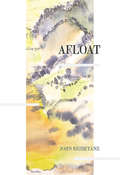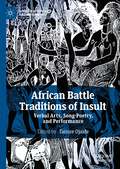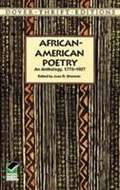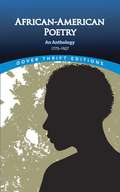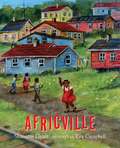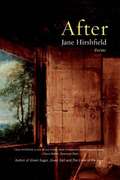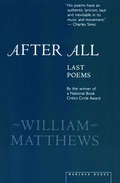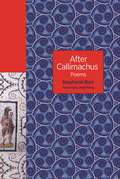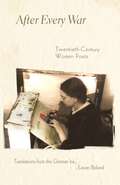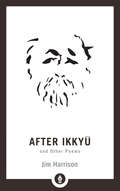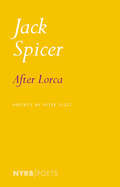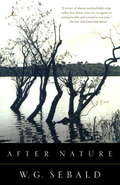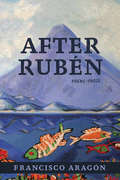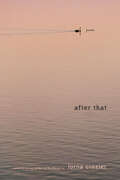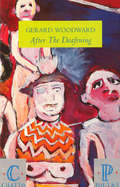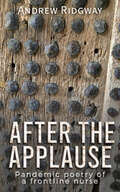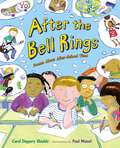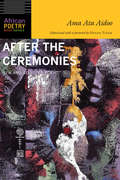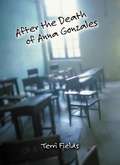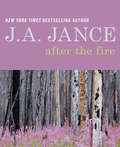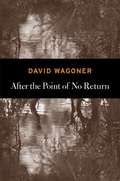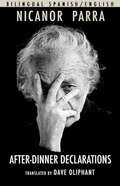- Table View
- List View
Afloat
by John ReibetanzAfloat, John Reibetanz's eighth collection of poetry, focuses on water in many manifestations. The centerpiece, a sequence on the Three Gorges Dam and its cultural and environmental implications, brings ancient Chinese sources (Meng Chiao and the painter Dong Yuan) together with modern ones (Edward Burtynsky's photographs and violent video games) to create an elegy that is moving and meditative. Although water is everywhere present as a subject, it is song that provides the motivating power, the vehicle of longing that animates the book. "We thirst for song"—the closing words of the Lament for the Gorges sequence—could really serve as the book's epigraph. This is poetry exercising its full range of possible functions (to observe, to enquire, to elegize, to imagine, to think, to commemorate, to yearn and to feel), all in the service of that "thirst for song."
Aforismos
by Leonardo Da VinciAforismos Leonardo Da Vinci Aforismos ofrece al lector una amplia y diversa colección de observaciones, pensamientos y máximas que recopilan el conocimiento e inteligencia de un genio como Leonardo da Vincicon su minucioso lenguaje descriptivo. "Pero la pintura tiene maravillosos artificios y sutilìsimas especulaciones que faltan a la escultura, la cual es de muy menguado discurso."
African Battle Traditions of Insult: Verbal Arts, Song-Poetry, and Performance (African Histories and Modernities)
by Tanure OjaideThis book explores the “battles” of words, songs, poetry, and performance in Africa and the African Diaspora. These are usually highly competitive, artistic contests in which rival parties duel for supremacy in poetry composition and/or its performance. This volume covers the history of this battle tradition, from its origins in Africa, especially the udje and halo of the Urhobo and Ewe respectively, to its transportation to the Americas and the Caribbean region during the Atlantic slave trade period, and its modern and contemporary manifestations as battle rap or other forms of popular music in Africa. Almost everywhere there are contemporary manifestations of the more traditional, older genres. The book is thus made up of studies of contests in which rivals duel for supremacy in verbal arts, song-poetry, and performance as they display their wit, sense of humor, and poetic expertise.
African-American Poetry: An Anthology 1773-1927
by Joan R. ShermanRich selection of 74 poems ranging from the religious and moral verse of Phillis Wheatley Peters (ca. 1753-1784) to 20th-century work of Langston Hughes and Countee Cullen. Other contributors include James Weldon Johnson, Paul Laurence Dunbar, many others. Indispensable for students of the black experience in America and any lover of fine poetry. Includes 4 selections from the Common Core State Standards Initiative: "I, Too, Sing America," "Lift Every Voice and Sing," "Yet Do I Marvel," and "On Being Brought from Africa to America. "
African-American Poetry: An Anthology, 1773-1927 (Dover Thrift Editions)
by Joan R. ShermanIn the 19th century, abolitionist and African-American periodicals printed thousands of poems by black men and women on such topics as bondage and freedom, hatred and discrimination, racial identity and racial solidarity, along with dialect verse that mythologized the Southern past. Early in the 20th century, black poets celebrated race consciousness in propagandistic and protest poetry, while World War I helped engender the outpouring of African-American creativity known as the "Harlem Renaissance."The present volume spans this wealth of material, ranging from the religious and moral verse of Phillis Wheatley Peters (ca. 1753-1784) to the 20th-century sensibilities of Langston Hughes and Countee Cullen. Also here are works by George Moses Horton, Frances Ellen Watkins Harper, Alberry Alston Whitman, Henrietta Cordelia Ray, Daniel Webster Davis, Mary Weston Fordham, James Weldon Johnson, Paul Laurence Dunbar, and many more.Attractive and inexpensive, this carefully chosen collection offers unparalleled insight into the hearts and minds of African-Americans. It will be welcomed by students of the black experience in America and any lover of fine poetry.Includes 4 selections from the Common Core State Standards Initiative: "I, Too, Sing America," "Lift Every Voice and Sing," "Yet Do I Marvel," and "On Being Brought from Africa to America."
Africville
by Shauntay GrantWinner of the Lillian Shepherd Memorial Award for Excellence in IllustrationFinalist for a Governor General’s Literary Award, Young People’s Literature – Illustrated BooksFinalist for a Ruth and Sylvia Schwartz Children’s Books AwardWhen a young girl visits the site of Africville, in Halifax, Nova Scotia, the stories she’s heard from her family come to mind. She imagines what the community was once like —the brightly painted houses nestled into the hillside, the field where boys played football, the pond where all the kids went rafting, the bountiful fishing, the huge bonfires. Coming out of her reverie, she visits the present-day park and the sundial where her great- grandmother’s name is carved in stone, and celebrates a summer day at the annual Africville Reunion/Festival.Africville was a vibrant Black community for more than 150 years. But even though its residents paid municipal taxes, they lived without running water, sewers, paved roads and police, fire-truck and ambulance services. Over time, the city located a slaughterhouse, a hospital for infectious disease, and even the city garbage dump nearby. In the 1960s, city officials decided to demolish the community, moving people out in city dump trucks and relocating them in public housing.Today, Africville has been replaced by a park, where former residents and their families gather each summer to remember their community.Key Text Featureshistorical contextreferencesCorrelates to the Common Core State Standards in English Language Arts:CCSS.ELA-LITERACY.RL.K.6With prompting and support, name the author and illustrator of a story and define the role of each in telling the story.CCSS.ELA-LITERACY.RL.1.3Describe characters, settings, and major events in a story, using key details.CCSS.ELA-LITERACY.RL.1.4Identify words and phrases in stories or poems that suggest feelings or appeal to the senses.CCSS.ELA-LITERACY.RL.1.7Use illustrations and details in a story to describe its characters, setting, or events.
After
by Jane HirshfieldAn investigation into incarnation, transience, and our intimate connection with all existence, by one of the preeminent poets of her generation
After All: Last Poems
by William MatthewsA collection from &“one of the few contemporary poets who really knew how to make the vernacular sing&” (Library Journal). In this collection of poems completed shortly before his death, William Matthews seems to be looking his last on all things lovely: music, food and wine, love. In the stunning central poem, &“Dire Cure,&” which forms a kind of spine to the book, he describes the remarkable implications of the &“heroic measures&” that saved the life and restored the health of his wife from &“a children&’s cancer (doesn&’t that possessive break your heart?).&” He evokes the death of his favorite jazz musician, Charles Mingus. He speaks of cats, dogs, pigs, sheep, of the past, of history, of joys proposed, but especially, with his characteristic relaxed wit, of language and its quiddities: &“My love says I think too damn much and maybe she&’s right.&” After All is the final word from this winner of the National Book Critics Circle Award and the Ruth Lilly Poetry Prize, one of the most pensive and delicious of all our poets. &“Range[s] widely and brightly from Prague in 1419 to a Caribbean island in 1967 to Martha Mitchell, Finn sheep, and a poetry reading at West Point. A lovely finale.&” —Library Journal &“His poems have an authentic lyricism, taut and inevitable in its music and movement.&” —Charles Simic, author of The Lunatic: Poems
After Callimachus: Poems (The Lockert Library of Poetry in Translation #139)
by Stephanie BurtContemporary translations and adaptations of ancient Greek poet Callimachus by noted writer and critic Stephanie BurtCallimachus may be the best-kept secret in all of ancient poetry. Loved and admired by later Romans and Greeks, his funny, sexy, generous, thoughtful, learned, sometimes elaborate, and always articulate lyric poems, hymns, epigrams, and short stories in verse have gone without a contemporary poetic champion, until now. In After Callimachus, esteemed poet and critic Stephanie Burt’s attentive translations and inspired adaptations introduce the work, spirit, and letter of Callimachus to today’s poetry readers.Skillfully combining intricate patterns of sound and classical precedent with the very modern concerns of sex, gender, love, death, and technology, these poems speak with a twenty-first century voice, while also opening multiple gateways to ancient worlds. This Callimachus travels the Mediterranean, pays homage to Athena and Zeus, develops erotic fixations, practices funerary commemoration, and brings fresh gifts for the cult of Artemis. This reimagined poet also visits airports, uses Tumblr and Twitter, listens to pop music, and fights contemporary patriarchy. Burt bears careful fealty to Callimachus’s whole poems, even as she builds freely from some of the hundreds of surviving fragments. Here is an ancient Greek poet made fresh for our current times. An informative foreword by classicist Mark Payne places Burt's renderings of Callimachus in literary and historical context.After Callimachus is at once a contribution to contemporary poetry and a new endeavor in the art of classical adaptation and translation.
After Dark: Poems about Nocturnal Animals
by David L. HarrisonThis collection of twenty-two poems explores the fascinating lives of North American nocturnal animals.When the sun goes down, many animals come out. Crickets chirp their crickety song hoping to attract a mate. Cougars bury their leftovers for later, leaving few clues for others to follow. Armadillos emerge from their dens to dig for worms, leaving holes in the lawns they disturb. This collection of poetry from acclaimed children's author and poet David L. Harrison explores the lives of animals who are awake after dark. Stephanie Laberis's beautifully atmospheric illustrations will draw in readers, and extensive back matter offers more information about each animal.
After Every War: Twentieth-Century Women Poets (Facing Pages)
by Eavan BolandThey are nine women with much in common—all German speaking, all poets, all personal witnesses to the horror and devastation that was World War II. Yet, in this deeply moving collection, each provides a singularly personal glimpse into the effects of war on language, place, poetry, and womanhood.After Every War is a book of translations of women poets living in Europe in the decades before and after World War II: Rose Ausländer, Elisabeth Langgässer, Nelly Sachs, Gertrud Kolmar, Else Lasker-Schüler, Ingeborg Bachmann, Marie Luise Kaschnitz, Dagmar Nick, and Hilde Domin. Several of the writers are Jewish and, therefore, also witnesses and participants in one of the darkest occasions of human cruelty, the Holocaust. Their poems, as well as those of the other writers, provide a unique biography of the time—but with a difference. These poets see public events through the lens of deep private losses. They chart the small occasions, the bittersweet family ties, the fruit dish on a table, the lost soul arriving at a railway station; in other words, the sheer ordinariness through which cataclysm is experienced, and by which life is cruelly shattered. They reclaim these moments and draw the reader into them.The poems are translated and introduced, with biographical notes on the authors, by renowned Irish poet Eavan Boland. Her interest in the topic is not abstract. As an Irish woman, she has observed the heartbreaking effects of violence on her own country. Her experience has drawn her closer to these nine poets, enabling her to render into English the beautiful, ruminative quality of their work and to present their poems for what they are: documentaries of resilience—of language, of music, and of the human spirit—in the hardest of times.
After Ikkyu and Other Poems: And Other Poems
by Jim HarrisonA spirited collection of poems inspired by the Zen practice of one of America's most celebrated authors, Jim Harrison, a New York Times best-selling author.The popular novels of Jim Harrison (1937–2016) represent only part of his literary output—he was also widely acclaimed for the “renegade genius” of his powerful, expressive poems. After Ikkyū is the first collection of Harrison’s poetry directly inspired by his many years of Zen practice. The writing here is at once thought-provoking and passionate, immortalizing a celebrated American writer’s relationship to Zen in beautiful verse. These short, spirited poems will inspire you to look at life differently with a newfound sense of wonder and gratitude for everyday moments.
After Lorca
by Jack SpicerOut of print for decades, this is the legendary American poet's tribute to Federico García Lorca, including translations of the great Spanish poet's work.Jack Spicer was one of the outstanding figures of the mid-twentieth-century San Francisco Renaissance, bent on fashioning a visionary new lyricism. Spicer called his poems &“dictations,&” and they combine outrageous humor, acid intelligence, brilliant wordplay, and sheer desolation to incandescent effect.&“Frankly I was quite surprised when Mr. Spicer asked me to write an introduction to this volume,&” writes the dead Federico García Lorca at the start of After Lorca, Spicer&’s first book and one that, since it originally appeared in 1957, has exerted a powerful influence on poetry in America and abroad. &“It must be made clear at the start that these poems are not translations,&” Lorca continues. &“In even the most literal of them Mr. Spicer seems to derive pleasure in inserting or substituting one or two words which completely change the mood and often the meaning of the poem as I had written it. More often he takes one of my poems and adjoins to half of it another of his own, giving rather the effect of an unwilling centaur. (Modesty forbids me to speculate which end of the animal is mine.) Finally there are an almost equal number of poems that I did not write at all (one supposes that they must be his).&” What so puzzles Lorca continues to delight and inspire readers of poetry today.
After Nature
by W. G. SebaldAfter Nature, W. G. Sebald's first literary work, now translated into English by Michael Hamburger, explores the lives of three men connected by their restless questioning of humankind's place in the natural world. From the efforts of each, "an order arises, in places beautiful and comforting, though more cruel, too, than the previous state of ignorance." The first figure is the great German Renaissance painter Matthias Grünewald. The second is the Enlightenment botanist-explorer Georg Steller, who accompanied Bering to the Arctic. The third is the author himself, who describes his wanderings among landscapes scarred by the wrecked certainties of previous ages. After Nature introduces many of the themes that W. G. Sebald explored in his subsequent books. A haunting vision of the waxing and waning tides of birth and devastation that lie behind and before us, it confirms the author's position as one of the most profound and original writers of our time.
After Rubén: Poems + Prose
by Francisco AragónThis collection of poetry, prose, and translations explores Latinx and queer identity through homage to the great Nicaraguan poet Rubén Darío.After Rubén unfolds a decades-long journey braiding together the personal, the political and the historical. Throughout the text, acclaimed poet Francisco Aragon intersperses English-language translations and riffs of the Spanish-language master Rubén Darío. Whether it’s biting portraits of public figures, or nuanced sketches of his father, Francisco Aragón has assembled his most expansive collection to date, evoking his native San Francisco, but also imagining ancestral spaces in Nicaragua.Readers will encounter pieces that splice lines from literary forebearers, a moving elegy to a sibling, a surprising epistle from the grave. In short, After Rubén presents a complex and fascinating conversation surrounding poetry in the Americas—above all as it relates to Latinx and queer poetics.
After That: Poems
by Lorna CrozierFrom Lorna Crozier, the poet that Ursula Le Guin called a &“truth teller&” and &“visionary,&” comes this new collection of soul-stirring poems that follow the death of a loved one.After That is a book written from the dark hollow we fall into when we lose those we love. Lorna Crozier&’s sure poetry finds the words to engage with the grief that comes from the death of her partner, the writer Patrick Lane, whom she&’d lived with for forty years, many of them tumultuous. With grace and precision, she illuminates sorrow. The light the poems cast travels far enough to reach anyone who has experienced loss. These pages engage us with many familiar yet magical things—not only paper wasps, but their libraries; not only herons, but their role as aging monks. Crozier takes us through the domestic and natural worlds into the cagey and metaphysical place we call the beyond. Without offering false comfort, the poems turn over our own grief so that we can catch a glimpse of the new life inside us again.
After The Deafening
by Gerard WoodwardWith the publication of his first book, HOUSEHOLDER, Gerard Woodward emerged as one of the most talented and unusual new poets of the 1990s. In his forthcoming collection AFTER THE DEAFENING, Woodward's powerful imagination, and the details of everyday life take on an extraordinary and exotic significance. 'A kind of punk anthropologist, his unsettling imagination violates all the thresholds between inner and outer. ' LONDON REVIEW OF BOOKS 'Vivid and rarely whimsical' OBSERVER 'There are enough poems in this collection which are both felt AND written to justify Woodward's claim on our attention. Where he exhibits emotional generosity, he is very good indeed. ' Carol Ann Duffy
After the Applause: Pandemic poetry of a frontline nurse
by Andrew Ridgway'Blurb' Contained within, Poetic words, some grim, of my recent experiences, during these times mysterious, of love and loyalty, and life’s’ great frailties, words of understanding, and observations on society, I share all this with you, humor, tears, happiness, fears, nakedly I bear my soul, for you to read, because we all need to forgive ourselves in times like these.
After the Bell Rings: Poems About After-School Time
by Carol Diggory ShieldsFresh, funny, and full of verve and variety, this clever book of 22 illustrated poems about school captures what kids love to do when class lets out. “Finally…. Finally…. Finally…. BRINNNNNG!That wonderful bell begins to ring. “Everyone knows that the best part of the school day is the moment it ends! After school, kids can hang out with their friends, play video games, attend music lessons, avoid chores, practice sports, do homework...well, maybe that last part isn't so great, but the rest is a blast!
After the Ceremonies: New and Selected Poems (African Poetry Book)
by Ama Ata Aidoo Helen YitahAma Ata Aidoo is one of the best-known African writers today. Spanning three decades of work, the poems in this collection address themes of colonialism, independence, motherhood, and gender in intimate, personal ways alongside commentary on broader social issues. After the Ceremonies is arranged in three parts: new and uncollected poems, some of which Aidoo calls “misplaced or downright lost”; selections from Aidoo’s An Angry Letter in January and Other Poems; and selections from Someone Talking to Sometime. Although Aidoo is best known for her novels Changes: A Love Story and Our Sister Killjoy, which are widely read in women’s literature courses, and her plays The Dilemma of a Ghost and Anowa, which are read and performed all over the world, her prowess as a poet shines in this collection.
After the Death of Anna Gonzales
by Terri FieldsPoems written in the voices of forty-seven people, including students, teachers, and other school staff, record the aftermath of a high school student's suicide and the preoccupations of teen life.
After the Death of Poetry: Poet and Audience in Contemporary America
by Vernon ShetleyIn this deft analysis, Vernon Shetley shows how writers and readers of poetry, operating under very different conventions and expectations, have drifted apart, stranding the once-vital poetic enterprise on the distant margins of contemporary culture. Along with a clear understanding of where American poetry stands and how it got there, After the Death of Poetry offers a compelling set of prescriptions for its future, prescriptions that might enable the art to regain its lost stature in our intellectual life.In exemplary case studies, Shetley identifies the very different ways in which three postwar poets--Elizabeth Bishop, James Merrill, and John Ashbery--try to restore some of the challenge and risk that characterized modernist poetry's relation to its first readers. Sure to be controversial, this cogent analysis offers poets and readers a clear sense of direction and purpose, and so, the hope of reaching each other again.
After the Fire
by J. A. JanceNew York Times bestselling author J. A. Jance's heartrending collection of poetry and essays recounts a dark chapter of her own life, her first marriage to an alcoholic--a powerful look at the emotional cost of addiction and an inspiring story of courage and triumph in the wake of crushing defeatBefore she found fame as a bestselling mystery author, Judith Jance wrestled with the anguish of being married to an alcoholic. For years she channeled her pain into words, composing the poems in this moving volume, first published in 1984, a year before her debut novel. In searing and direct language, After the Fire chronicles the collapse of Jance's first marriage under the weight of her husband's addiction--and her own unwitting denial and codependence while she struggled to find herself. "I will not be the price of your redemption," she wrote then. "I will not pay my life to ransom yours. "An intimate, deeply personal look into a wrenching time in Jance's life, After the Fire is a portrait of addiction and its insidious effects on lives and love. It illuminates universal truths about unbearable loss and finding the courage to carry on, and offers inspiration and profound insight into the heart and work of a beloved bestselling author.
After the Point of No Return
by David Wagoner"Wagoner's words are a living link to the world, enacting it so vitally that they feel like natural facts."-The Seattle TimesIn his twenty-fourth book of poetry, David Wagoner reflects on youth, love, regret, and expectation versus reality. Here a master writes at top form, back-dropped by life's curious moments and imagining Jesus as an untidy roommate or considering our final destination in "Beginner's Guide to Death.""After the Point of No Return"After that moment when you've lost all reasonfor going back where you started, when going aheadis no longer a Yes or No, but a matter of fact,you'll need to weigh, on the one hand, what will seem,on the other, almost nothing against somethingslightly more than nothing and must chooseagain and again, at points of fewer and fewerchances to guess, when and which way to turn.That's when you might stop thinking about starsand storm clouds, the direction of wind,the difference between rain and snow, the time of day or the lay of the land, about which treesmean water, which birds know what you needto know before it's too late, or what's right hereunder your feet, no longer able to tell youwhere it was you thought you had to go.David Wagoner is the author of two dozen books of poetry and ten novels. A longtime teacher at University of Washington, he was the editor at Poetry Northwest. He lives in Seattle, Washington.
After-Dinner Declarations
by Nicanor ParraPoetry. Latin American Studies. Bilingual edition. Translated from the Spanish by Dave Oliphant. In the 235 poems that make up these collected declarations, renowned Chilean "antipoet" Nicanor Parra provides an entertaining and enlightening perspective on the modern world. Delivered as a series of five "verse speeches" during the 1990s, the poems in After-Dinner Declarations eschew literary ostentation in favor of playful, conversational musings. In a language steeped in colloquialisms, Parra's declarations employ a diverse range of discourses--from puns and allusions to diatribes and eulogies--in order to expose the hypocrisy of human institutions and offer a quipping challenge to those who remain satisfied with the status quo. Parra uses his linguistic brilliance and logical ingenuity to confront some of the most serious problems of our day, addressing perennial motifs such as ecology, human rights and responsibilities, and the limits of scientific knowledge. As the antipoet moves deftly from one topic to another with unbounded inventiveness, he discovers for us a wealth of political, philosophical, and literary insights, as well as unexpected connections between ideas that shape our lives.
